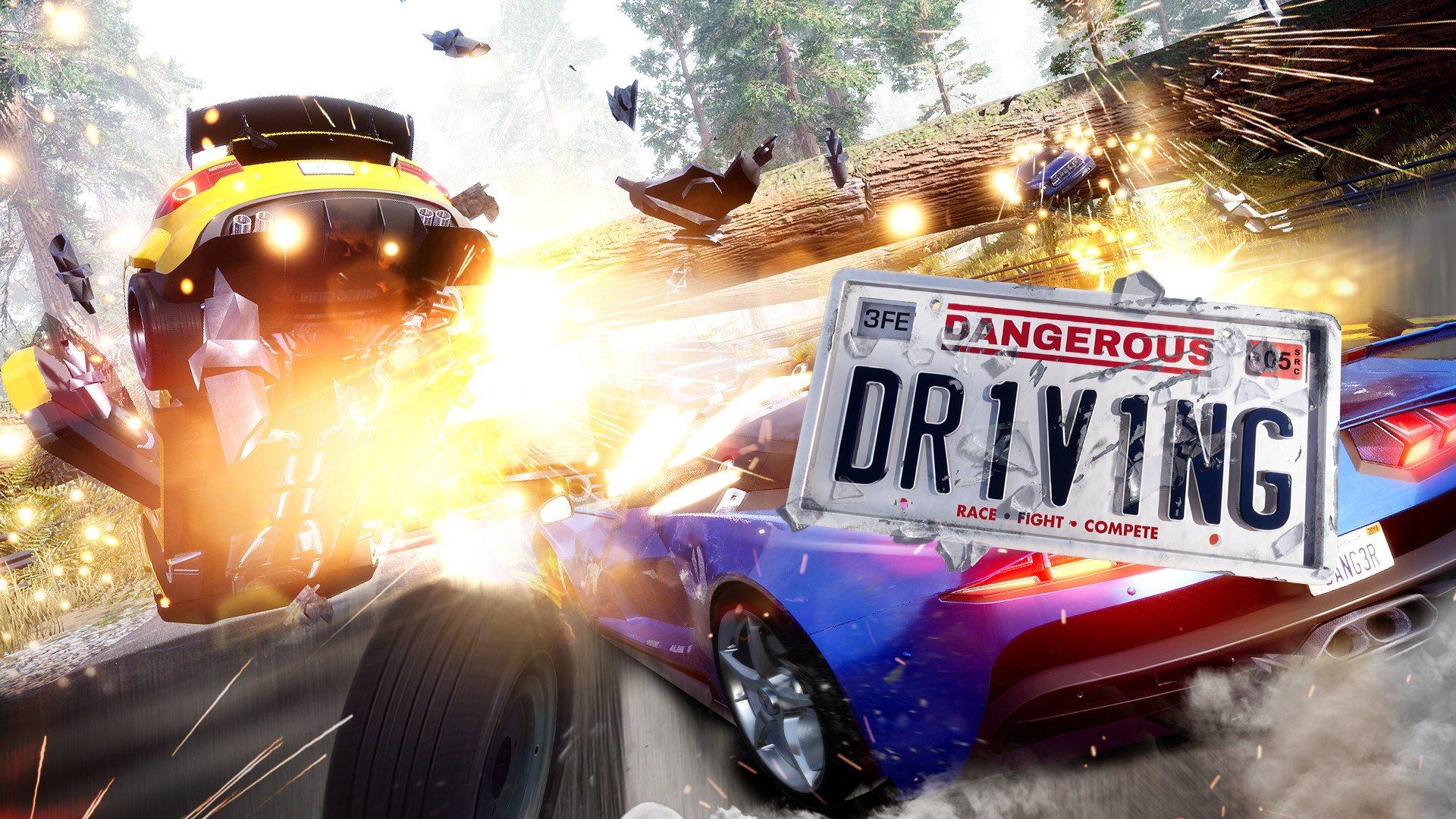The Matrix was a cinematic triumph, on that, I think most of us can agree. As a masterful blend of science fiction, action, and thought-provoking themes, it is entirely the sum of its parts, and perfectly balanced. Like anything innovative and fresh, a sequel was inevitable (if not entirely necessary), and we would eventually receive a conclusion to the story, albeit split between two sequels: The Matrix Reloaded, and The Matrix Revolutions.
The reception was mixed, to say the least.
While the sequels were well received for the time, there’s no denying that they would have worked better as a single film. However, when watched back to back, something interesting happens. Many of the flaws crossing each film are much easier to take in an extended viewing, with both films complimenting one another as a unified narrative.
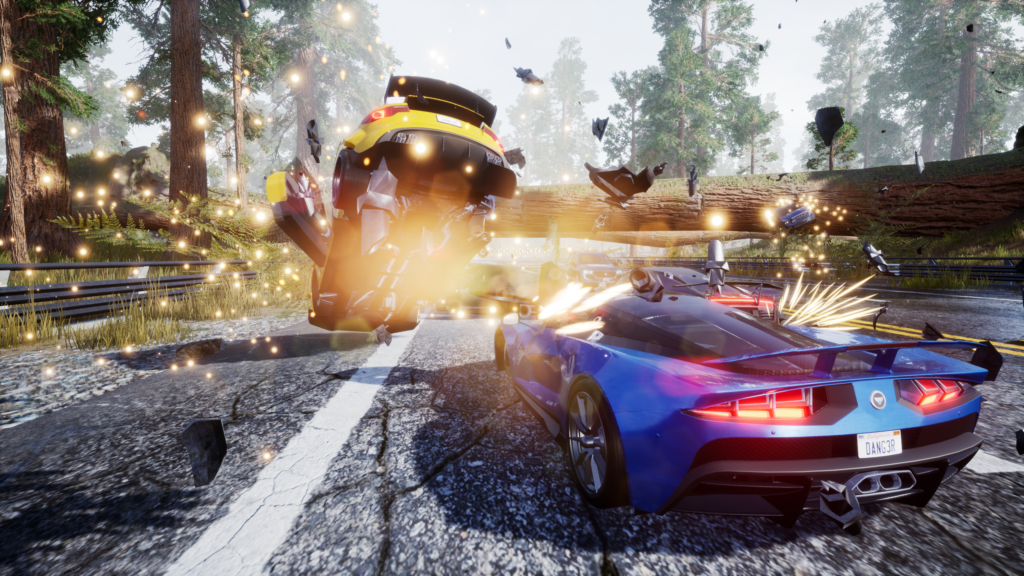
No more has such a dichotomy existed in a game than the one presented here by Dangerous Driving. The developer, Three Fields Entertainment clearly loves Burnout so much so that they’ve already produced two games in homage to its Crash Mode in the form of their Danger Zone series. Though both games received a mostly positive critical reception, the consensus was that both titles sorely needed dedicated racing modes. Peanut butter to compliment the jelly, as it were.
Fast forward to 2019, and after much anticipation, their newest title Dangerous Driving seeks to rectify this omission. From the outset, It’s obvious that the game is meant to be a spiritual successor to Burnout 3: Takedown, but like Danger Zone before it, it’s only packing half of the experience, this time championing the race mode without the crash to compliment it. Basically, if Burnout 3 is The Matrix of battle racers, then Dangerous Driving is The Matrix Revolutions to Danger Zone‘s Matrix Reloaded.
One can only wonder what continues to compel Three Fields to recreate the Burnout formula in pieces, spread across multiple titles instead of a single tight, well-rounded package, but like any sequel unnecessarily split in two parts, what we have here is an experience that nails what it’s going for, but is also lacking in key areas, much like the title before it.
Dividing the Pie
This game isn’t Three Fields’ first go around this concept. Through Danger Zone and its sequel, they’ve already demonstrated that they understand what makes an old-school arcade racer fun and visually exciting. Whether it’s smashing your opponents and rivals off the track to achieve victory, or replacing the apprehension of a mid-race goof with the catharsis of seeing what used to be your (or your rival’s) car flip down a road uncontrollably, the game initially feels like the resurgence of a genre lost, and a return to form. From the second the game actually loads, its influences are clear, albeit with a catch that becomes immediately evident—it looks pretty rough around the edges. The menus are static, the load screens have phrasing that often slips into parody (“HAVE YOU TRIED…PLACING IN 1ST?”) and the lack of any distinct personality like an announcer or host driving the proceedings leave the game’s presentation feeling a bit cold.
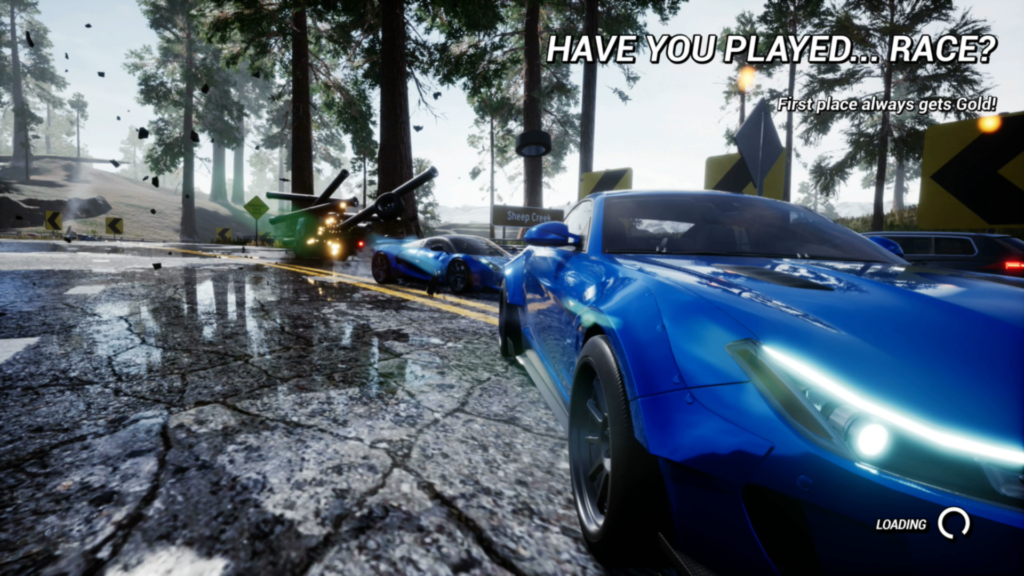
In any other situation, this would be a major ding against the game, but it is clear from top to bottom that Three Fields had very limited resources to work with, and used everything they had to the best of their ability. So really, the first barrier to enjoying this game lies in asking this simple question: If the core driving experience achieves exactly what the developer was going for, will a small omission here and there really affect the overall package?
This is a recurring question that continues to rear its head even as you work through the Dangerous Driving Tour, the game’s only playable mode at launch (Multiplayer will be added later as DLC). Made up of over 69 events, it plays out less like a seasonal event, and more like a huge what-if mode that combines every car class, with each race variation you can think of. The classes are unlocked in stages, starting with SUVs, and coupes before scaling the speedometer up to the level of supercars and Formula One racers. Modes are plentiful and varied as well. Unlocking gradually over time, there are regular races, Time Attack events that usually consist of a single lap or Road Rage events that task you with taking out a set number of cars under a time limit. If that isn’t enough, there are also Shakedown events where you play the role of a cop chasing outlaws, Hot Pursuit style. 1 on 1 Face Off races put the revenge squarely in your hands with a single opponent, and if you’re truly a thrill seeker, there are Survival races that end with merely a single crash. When you’re dealing with speeds that hover around 230mph on average, these can all range from nerve-wracking to a rocking good time.
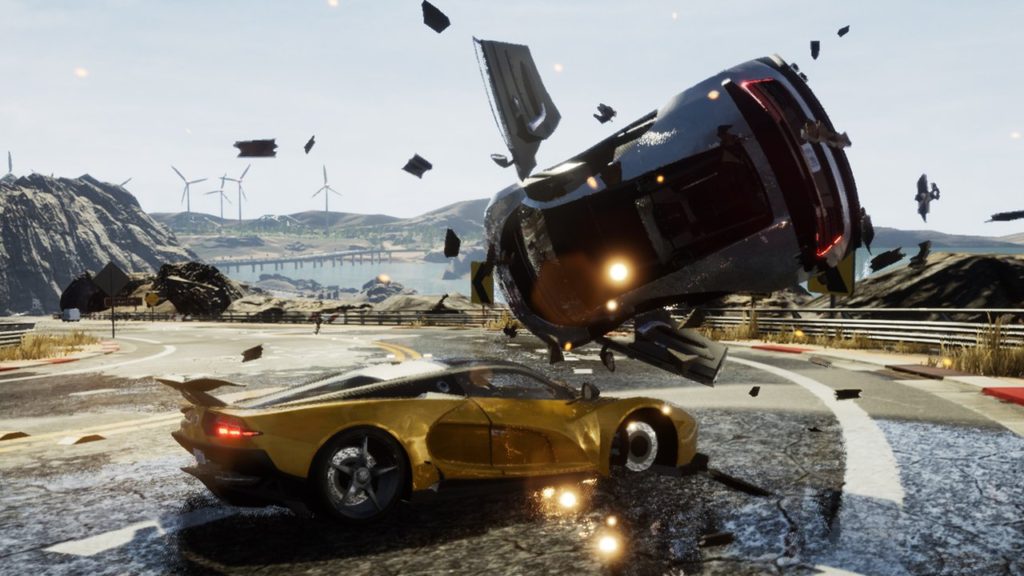
Of course, having all of these activities would mean little if the game weren’t fun to actually play, and it’s in this area that Three Fields succeeds. Dangerous Driving lives up to its name by asking you to do just that, and the controls are smooth, and tight, which is a must for a game that moves as fast as it does. The learning curve asks nothing more of you than drifting, and boosting, and the mechanics behind it are solid, while still easy enough to pick up for newcomers. Earning boost, the cornerstone of the game’s meta comes from aggressive driving, smooth drifting, and reckless behavior. While that may sound vague on paper, trust me when I say it all works in practice. If there’s a better way to describe driving on the wrong side of traffic while drifting your opponent into a T-bone wreck, feel free to @ me on social media. It’s just something that happens, and happens often enough that it’ll instantly become a part of your driving instincts, should you stick with it in the long term.
Fork In The Road
Of course, you can’t win them all, and I saved a special spot in the review to discuss Eliminator, a mode that makes full use of the game’s well-intentioned, yet abrasively implemented persistent wreck mechanic.
Persistent wrecks are a “feature” of Dangerous Driving that leaves every mid-race crash on the track as an obstacle for the remainder of the race. It’s a throwaway detail that you can mostly ignore due to the game’s pace and event brevity, but in this particular mode, it’s impossible to do so. True to its name, after each lap in Eliminator, the person in last is removed until there’s one car left standing. Six cars on the track equal six laps. Six laps of racing. Six laps…of crashing, and six laps worth of wrecks between you and the 5 other AI drivers, whether intentionally made or not.
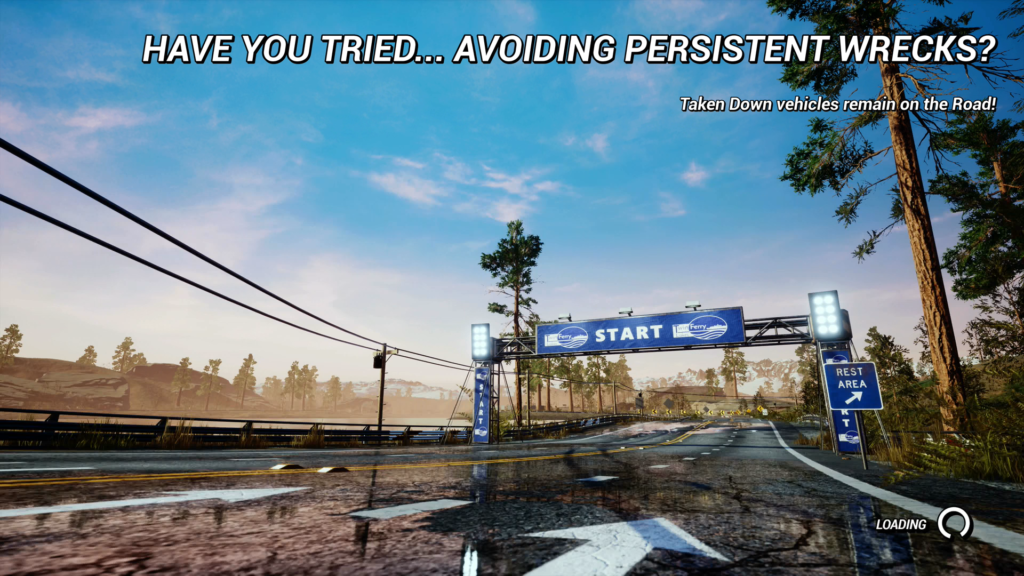
Since the game has some pretty aggressive rubberbanding that keeps AI racers well within your pace no matter how well you drive, what you end up with is a frustrating, increasingly cheap feeling race with zero margin for error as the inevitable wrecks from laps prior gunk up the track and turn it into a high speed obstacle course. This is not as fun as it sounds, especially when the track design often leads you into long, blind drifting turns while driving into oncoming traffic. It’s in this mode and this mode alone that you see the potential behind having persistent wrecks–and also why the mechanic just doesn’t work as well in practice as Three Fields might have thought it would in theory.
Despite this hiccup, the tracks themselves are well designed, and play to the game’s breakneck pace and emphasis on drifting exceptionally. Set against the backdrop of cross-country highways, many tracks feature straight roads aplenty for building up speed, broken bridges that break off into huge jumps, and unbelievably long turns built for drifting, giving even Ridge Racer a run for its money. Guardrails line every track, inviting one to use them as a buffer for eking out clutch turns as much as a constant reminder of where to send your opponents for maximum spectacle. The visuals do as much as they can to be distinct between each highway, with different seasons and background elements to separate them, but can be a bit difficult telling them apart when they all share the same aesthetic.
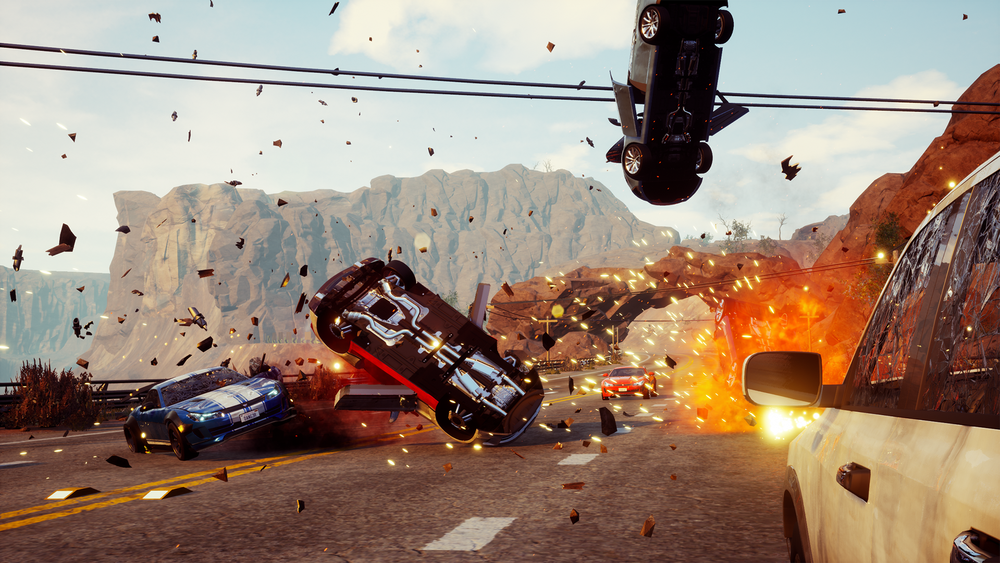
Speaking of aesthetic, we have to take a moment to talk about the game’s music, or lack thereof. In place of a soundtrack, the game has Spotify integration that allows you to play music from your own playlists, or one specifically curated by Three Fields to use in-game. This is great, and innovative, yet oddly restrictive and somewhat detrimental to the game’s tone. Music matters, and by default, this integration aside, the game actually has no voice of its own. Burnout 3: Takedown had a poppy, punk rock aesthetic that went well with the game’s colorful visuals and rebellious direction, whereas Burnout Revenge had more metal and alt-rock to reflect how aggressive the gameplay had become. With no soundtrack aside from the one you give it, the game sorely lacks an identity, and even then, that’s IF you even have Spotify to begin with.
There’s no support for other music services such as Tidal, Soundcloud, iTunes, etc, so again, unless you have Spotify, you’ll have nothing but the sound of metal on metal punctuating the experience as you say hello to darkness, your old friend. I’ll give full credit to the integration, and I do genuinely think it’s an innovative feature I’d love to see used in more titles in the future, but it would’ve done better alongside an actual soundtrack.
So Dangerous Driving looks fine, plays even better, and manages to provide an authentic Burnout experience despite its flaws. What the game lacks in terms of presentation and style can be forgiven, but the exclusion of any other modes, especially multiplayer in a racing game at launch may be a dealbreaker for some. Onrush, a game released in mid-2018 in a similar state was deeply hurt by a lack of a solid, ranked multiplayer mode for months after release, and the game suffered for it in the long run. I’d hate to see the same happen here, but without any defining community features, there’s little reason to discuss or talk about the game outside of its momentary thrills as a single-player racing game. Sure there are leaderboards, but does anyone really care that I smashed a few more cars than them, or beat them in a race by a few milliseconds if they weren’t there to actually witness it?
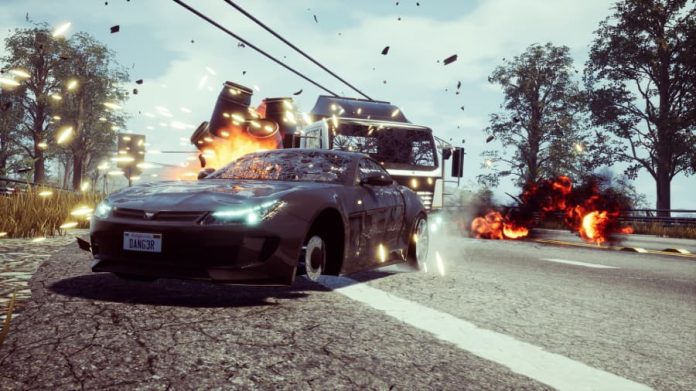
What we have here is a game that is relentlessly, unapologetically what it is, for better or worse. Dangerous Driving is fun, relentless, and in your face with challenges aplenty due to its densely structured tour mode, and has controls that are so fine-tuned, your controller disappears after your first hour in. As a homage to old school arcade racers and obviously Burnout, it succeeds, but the lack of a crash mode or any defining social aspect outside of leaderboards is a letdown. When you consider the state of the Danger Zone titles and how they actually compliment this one in a vacuum, it’s clear that Three Fields is capable of designing a complete Burnout-lite experience. Unfortunately, the selective omissions, whether due to design or budget constraints conspire to bruise the entire package in the long run. Somewhere in this 5GB download is a fun, exciting game that absolutely deserves all of the play and recognition it can get, but even at its budget price, it’s a hard sell to anyone but the most diehard Burnout fans.

